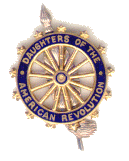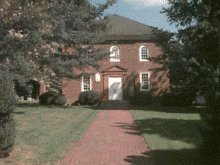

Daughters of the American Revolution
Falls Church, Virginia
The Falls Church Chapter NSDAR was organized on June 7, 1910, with Mrs. W. Edward Callender as the Organizing Regent. It was named for The Falls Church (Episcopal), originally built in 1733 and established in 1734. The Chapter had 16 organizing members and 22 charter members.
Activities
Officers



The name The Falls Church came from its geographical location. Among the very few, widely separated churches in the parish, this church was identified as the one that was near the falls of the Potomac River. One of the roads which intersected near the church led to the ferry below the Little Falls. The Falls Church was the name commonly used after 1757. The name Falls Church was adopted by the Community which developed around the church, and subsequently by the city when it was incorporated in 1948.
In 1762 the wood building was judged to be greatly in decay. The vestry meeting at The Falls Church ordered a new brick building constructed on the same site. In 1763, George Washington and George William Fairfax were appointed church wardens with responsibility to contract for a new building.
The two-story, hip-roof, Georgian-style church was designed and built by James Wren in 1767-69 from local bricks laid in Flemish bond design; it is adjacent to the site of the original wooden structure. It is the oldest remaining church building north of Quantico in Virginia.
During the Revolutionary War, the building was a recruiting station for the Fairfax militia. Tradition holds that the Declaration of Independence was read to local citizens from the steps of the south doors. After the war and disestablishment of the Church of England, The Falls Church entered a period of dwindling activity that lasted until the late 1830s. During the Civil War, the church was used by Union troops as a hospital and later as a stable, suffering damage still visible at the south door and some windows. The church vestry was not formally reorganized until 1873, but has been active since then. The chancel was enlarged in 1959 and a major addition was completed in 1992. The 1760s church is still in use.
The DAR Insignia is the property of, and is copyrighted by, the National Society of the Daughters of the American Revolution.
Web hyperlinks to non-DAR sites are not the responsibility of the NSDAR, the state organizations, or individual DAR chapters.